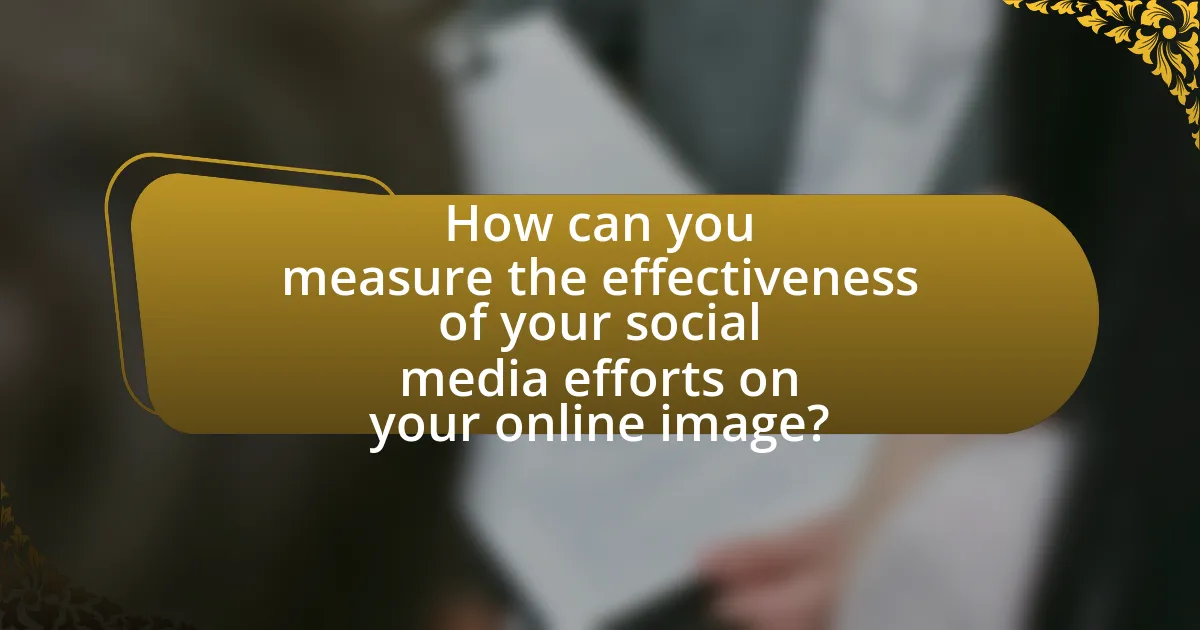Leveraging social media content is essential for enhancing one’s online image, as it involves strategically curating and sharing posts, interactions, and multimedia that align with personal or brand identity. The article explores how social media content shapes online presence, the effectiveness of various content types, and the importance of audience engagement in building trust and credibility. It also discusses the risks associated with a poor online image, strategies for managing and improving online reputation, and best practices for creating a consistent brand voice across platforms. Key metrics for measuring social media effectiveness and common pitfalls to avoid are also highlighted, providing a comprehensive guide for individuals and brands aiming to optimize their online image through social media.

What does it mean to leverage social media content for your online image?
Leveraging social media content for your online image means strategically using posts, interactions, and multimedia to shape how you are perceived by your audience. This involves curating and sharing content that aligns with your personal or brand identity, thereby enhancing visibility and engagement. Research indicates that 73% of marketers believe that their efforts through social media marketing have been “somewhat effective” or “very effective” for their business (Buffer, 2021). By consistently presenting a cohesive narrative and engaging with followers, individuals and brands can build a positive online reputation and foster trust.
How can social media content shape your online presence?
Social media content shapes your online presence by influencing public perception and engagement. The type of content shared, including posts, images, and videos, directly impacts how individuals and brands are viewed by their audience. For instance, a study by the Pew Research Center found that 69% of adults in the U.S. use social media, indicating its significant role in shaping opinions and relationships. Positive, engaging content can enhance credibility and foster community, while negative or inconsistent messaging can damage reputation and trust. Therefore, the strategic use of social media content is crucial for effectively managing and enhancing one’s online image.
What types of social media content are most effective for enhancing your image?
Visual content, such as high-quality images and videos, is the most effective type of social media content for enhancing your image. Research indicates that posts with visuals receive 94% more views than those without, significantly increasing engagement and brand perception. Additionally, user-generated content, which showcases real customers using a product or service, fosters authenticity and trust, further enhancing an individual’s or brand’s image. According to a study by Nielsen, 92% of consumers trust recommendations from individuals over brands, highlighting the importance of relatable content in building a positive online image.
How does audience engagement influence your online image?
Audience engagement significantly shapes your online image by directly affecting perceptions of credibility and relatability. High levels of interaction, such as likes, shares, and comments, signal to potential followers that your content resonates with others, enhancing your reputation. For instance, a study by the Pew Research Center found that 70% of users are more likely to trust brands that actively engage with their audience on social media. This trust translates into a stronger online presence and can lead to increased follower growth and brand loyalty.
Why is it important to manage your online image through social media?
Managing your online image through social media is crucial because it directly influences personal and professional opportunities. A well-curated online presence can enhance credibility, attract potential employers, and foster positive relationships. According to a survey by CareerBuilder, 70% of employers use social media to screen candidates, highlighting the importance of a favorable online image in the job market. Furthermore, a positive online reputation can lead to increased networking opportunities and brand partnerships, as 54% of consumers report that they research a brand’s social media presence before making a purchase decision. Thus, actively managing one’s online image is essential for success in both personal and professional realms.
What risks are associated with a poor online image?
A poor online image can lead to significant risks, including damage to personal or brand reputation, loss of job opportunities, and decreased trust from customers or clients. Research indicates that 70% of employers use social media to screen candidates, and a negative online presence can result in disqualification from job consideration. Additionally, businesses with poor online reputations may experience a 22% decrease in customer trust, impacting sales and customer loyalty. These statistics underscore the importance of maintaining a positive online image to mitigate these risks effectively.
How can a positive online image benefit personal and professional opportunities?
A positive online image can significantly enhance personal and professional opportunities by increasing visibility and credibility. Individuals with a favorable online presence are often perceived as more trustworthy and competent, which can lead to job offers, promotions, and networking opportunities. Research indicates that 70% of employers use social media to screen candidates, highlighting the importance of a positive digital footprint in the hiring process. Furthermore, a strong online image can attract potential clients and collaborators, as businesses often seek partners with a reputable online presence.

What strategies can you use to enhance your online image through social media?
To enhance your online image through social media, consistently create high-quality, engaging content that reflects your personal brand. This involves sharing valuable insights, showcasing expertise, and maintaining a professional tone across platforms. Research indicates that 70% of employers use social media to screen candidates, highlighting the importance of a positive online presence. Additionally, engaging with your audience through comments and messages fosters community and trust, further solidifying your image. Regularly updating your profiles and utilizing analytics tools to track engagement can also help refine your strategy and ensure alignment with your branding goals.
How can you create a consistent brand voice across platforms?
To create a consistent brand voice across platforms, establish clear brand guidelines that define tone, language, and messaging. These guidelines should be documented and shared with all team members involved in content creation, ensuring everyone understands and adheres to the same voice. Research indicates that brands with consistent messaging can achieve up to 23% more revenue, highlighting the importance of uniformity in communication. By regularly reviewing and updating these guidelines based on audience feedback and platform-specific nuances, brands can maintain a cohesive identity that resonates across various channels.
What elements contribute to a strong brand voice on social media?
A strong brand voice on social media is defined by consistency, authenticity, and audience engagement. Consistency ensures that the brand’s messaging, tone, and style remain uniform across all platforms, which helps in building recognition and trust. Authenticity involves being genuine and transparent, allowing the audience to connect with the brand on a personal level. Audience engagement is crucial as it fosters interaction and builds community, making followers feel valued and heard. Research by Sprout Social indicates that brands with a consistent voice see a 33% increase in audience engagement, highlighting the importance of these elements in establishing a strong brand presence.
How can you adapt your brand voice for different social media platforms?
To adapt your brand voice for different social media platforms, tailor your messaging style to align with the unique characteristics and audience expectations of each platform. For instance, on Twitter, brevity and wit are essential due to character limits, while Instagram favors visual storytelling and a more casual tone. Research indicates that 71% of consumers are more likely to make a purchase based on social media referrals, highlighting the importance of a platform-specific approach. By understanding the demographics and user behavior on platforms like LinkedIn, which values professionalism, versus TikTok, which thrives on creativity and humor, brands can effectively engage their target audience and enhance their online image.
What role does content quality play in enhancing your online image?
Content quality is crucial in enhancing your online image as it directly influences audience perception and engagement. High-quality content establishes credibility, fosters trust, and encourages sharing, which amplifies visibility. For instance, a study by the Content Marketing Institute found that 70% of consumers prefer to learn about a company through articles rather than ads, indicating that well-crafted content can significantly improve brand reputation. Additionally, search engines prioritize high-quality content in their algorithms, leading to better search rankings and increased traffic. Therefore, investing in content quality not only shapes a positive online image but also drives measurable business outcomes.
How can you ensure your content is engaging and relevant?
To ensure your content is engaging and relevant, focus on understanding your target audience’s interests and preferences. Conduct surveys or analyze social media interactions to gather insights about what resonates with them. For instance, a study by HubSpot found that 70% of consumers prefer to learn about a company through articles rather than ads, indicating that informative and valuable content is more engaging. Additionally, regularly updating your content to reflect current trends and incorporating multimedia elements, such as images and videos, can enhance engagement. By aligning your content strategy with audience preferences and current trends, you can maintain relevance and foster a deeper connection with your audience.
What tools can help improve the quality of your social media content?
Tools that can help improve the quality of social media content include Canva, Hootsuite, and Grammarly. Canva provides a user-friendly platform for creating visually appealing graphics and posts, which can enhance engagement. Hootsuite allows for effective scheduling and analytics, enabling users to optimize posting times and track performance metrics. Grammarly ensures that the text is grammatically correct and stylistically appropriate, improving overall content quality. These tools collectively contribute to more professional and engaging social media presence, supported by their widespread use among marketers and content creators.

How can you measure the effectiveness of your social media efforts on your online image?
To measure the effectiveness of social media efforts on your online image, analyze key performance indicators (KPIs) such as engagement rates, follower growth, and sentiment analysis. Engagement rates, which include likes, shares, and comments, indicate how well your content resonates with the audience. For instance, a 2% engagement rate is considered average, while higher rates suggest stronger audience connection. Follower growth reflects the expanding reach of your brand; a consistent increase in followers can signify a positive online image. Sentiment analysis, which evaluates the tone of comments and mentions, provides insight into public perception; tools like Brandwatch or Hootsuite can quantify sentiment, revealing whether it skews positive, negative, or neutral. Collectively, these metrics offer a comprehensive view of how social media efforts shape your online image.
What metrics should you track to assess your online image?
To assess your online image, track metrics such as engagement rate, sentiment analysis, brand mentions, and follower growth. Engagement rate, calculated by dividing total interactions by total followers, indicates how well your audience connects with your content. Sentiment analysis measures the emotional tone of comments and mentions, providing insight into public perception. Brand mentions, tracked through social listening tools, reveal how often your brand is discussed across platforms, while follower growth indicates the effectiveness of your outreach and content strategy. These metrics collectively provide a comprehensive view of your online reputation and audience perception.
How can engagement rates inform your strategy?
Engagement rates can inform your strategy by providing insights into audience preferences and content effectiveness. High engagement rates indicate that your content resonates with your audience, allowing you to refine your messaging and focus on similar themes or formats that drive interaction. For instance, a study by HubSpot found that posts with higher engagement rates lead to increased brand loyalty and customer retention, demonstrating the importance of aligning content with audience interests. By analyzing engagement metrics, you can optimize your social media strategy to enhance your online image and foster stronger connections with your audience.
What tools can help you analyze your social media performance?
Tools that can help analyze social media performance include Hootsuite, Sprout Social, and Google Analytics. Hootsuite provides comprehensive analytics on engagement, reach, and audience demographics across multiple platforms, allowing users to track performance metrics effectively. Sprout Social offers in-depth reporting features that highlight trends and engagement rates, enabling businesses to optimize their content strategy. Google Analytics can track referral traffic from social media, providing insights into user behavior and conversion rates. These tools are widely recognized for their effectiveness in measuring social media performance, with Hootsuite serving over 18 million users and Sprout Social being used by more than 30,000 brands, demonstrating their reliability and impact in the industry.
What are some common pitfalls to avoid when leveraging social media for your online image?
Common pitfalls to avoid when leveraging social media for your online image include oversharing personal information, engaging in negative interactions, and neglecting audience engagement. Oversharing can lead to privacy issues and damage your reputation, as seen in cases where individuals faced backlash for revealing too much personal detail. Engaging in negative interactions, such as arguments or inflammatory comments, can tarnish your image and alienate potential followers, evidenced by numerous public figures losing credibility after online disputes. Lastly, neglecting audience engagement can result in a lack of connection with your audience, leading to decreased visibility and influence, as social media algorithms favor active and engaging accounts.
How can negative feedback impact your online image?
Negative feedback can significantly damage your online image by influencing public perception and trust. When individuals or brands receive negative comments or reviews, potential customers may be deterred from engaging with them, leading to decreased credibility. Research indicates that 86% of consumers read reviews for local businesses, and 57% will only consider a business if it has a rating of four stars or higher. This demonstrates that negative feedback can directly affect consumer behavior and decision-making. Furthermore, negative feedback can spread rapidly on social media platforms, amplifying its impact and potentially leading to a long-lasting negative reputation.
What strategies can mitigate the effects of negative comments or reviews?
To mitigate the effects of negative comments or reviews, businesses should implement proactive engagement strategies. Responding promptly and professionally to negative feedback demonstrates a commitment to customer satisfaction and can help to de-escalate potential conflicts. Research indicates that 70% of consumers are more likely to use a business that responds to reviews, highlighting the importance of engagement in maintaining a positive online image. Additionally, encouraging satisfied customers to leave positive reviews can dilute the impact of negative ones, as a higher volume of positive feedback can improve overall ratings. Monitoring social media channels for mentions and addressing concerns in real-time further reinforces a brand’s dedication to its audience, ultimately enhancing its online reputation.
What best practices can you implement to enhance your online image through social media?
To enhance your online image through social media, consistently share high-quality, relevant content that aligns with your personal or brand values. Engaging with your audience through comments, messages, and shares fosters community and builds trust. Additionally, maintaining a professional profile picture and bio across platforms ensures a cohesive brand identity. Research indicates that 70% of employers use social media to screen candidates, highlighting the importance of a positive online presence. Regularly monitoring your online reputation and responding promptly to feedback can further strengthen your image.
How can you effectively engage with your audience to build a positive image?
To effectively engage with your audience and build a positive image, consistently create high-quality, relevant content that resonates with their interests and needs. Engaging content fosters interaction, encourages sharing, and enhances brand loyalty. According to a study by HubSpot, 54% of consumers want to see more video content from brands they support, indicating that utilizing diverse formats can significantly improve audience engagement. Additionally, responding promptly to comments and messages demonstrates attentiveness, which can enhance trust and credibility. Engaging with your audience through polls, questions, and user-generated content also encourages participation and strengthens community ties, further solidifying a positive image.
What content types should you prioritize for maximum impact?
To achieve maximum impact, prioritize video content, infographics, and user-generated content. Video content is highly engaging, with studies showing that it can increase user retention by up to 95% compared to text-based content. Infographics effectively convey complex information visually, leading to a 30% increase in engagement rates. User-generated content fosters community and trust, as 79% of consumers say user-generated content highly impacts their purchasing decisions. These content types not only enhance visibility but also drive interaction and conversion rates on social media platforms.

Leave a Reply